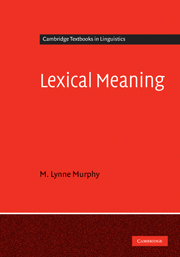Book contents
- Frontmatter
- Contents
- List of figures
- Preface: using this book
- Acknowledgments
- Typographical conventions
- Part I Meaning and the lexicon
- Part II Relations among words and senses
- Part III Word classes and semantic types
- 7 Ontological categories and word classes
- 8 Nouns and countability
- 9 Predication: verbs, events, and states
- 10 Verbs and time
- 11 Adjectives and properties
- References
- Index
9 - Predication: verbs, events, and states
from Part III - Word classes and semantic types
Published online by Cambridge University Press: 05 June 2012
- Frontmatter
- Contents
- List of figures
- Preface: using this book
- Acknowledgments
- Typographical conventions
- Part I Meaning and the lexicon
- Part II Relations among words and senses
- Part III Word classes and semantic types
- 7 Ontological categories and word classes
- 8 Nouns and countability
- 9 Predication: verbs, events, and states
- 10 Verbs and time
- 11 Adjectives and properties
- References
- Index
Summary
Key words:
verb, predicate, argument, alternation, conf lation, event, state, motion verb, f igure, ground, path, manner, causative, copula, relational adjective, relational noun, preposition
Overview
Grammatically speaking, sentences (at least in English) are organized around a main verb, while semantically speaking the heart of a sentence is its main predicate, which is often represented by a verb. Sentences represent situations (either states or events), and so verbs can be expected to play a big part in the expression of situations. But a verb itself usually does not express a complete situation – so verbs interact semantically with other parts of the sentence, their arguments, in order to represent complete situations. This chapter starts with a focus on verb meaning, since most verbs have predicative meanings and verbs are central to sentences. The next section discusses predication, followed by a section on differentiating states and events. We look at these distinctions and at the relationship between verbs and other participants in states/events through a detailed analysis of motion verbs, particularly with reference to Jackendoff's Conceptual Semantics model. At the end of this chapter we examine how other word classes can serve as semantic predicates too.
- Type
- Chapter
- Information
- Lexical Meaning , pp. 172 - 200Publisher: Cambridge University PressPrint publication year: 2010

